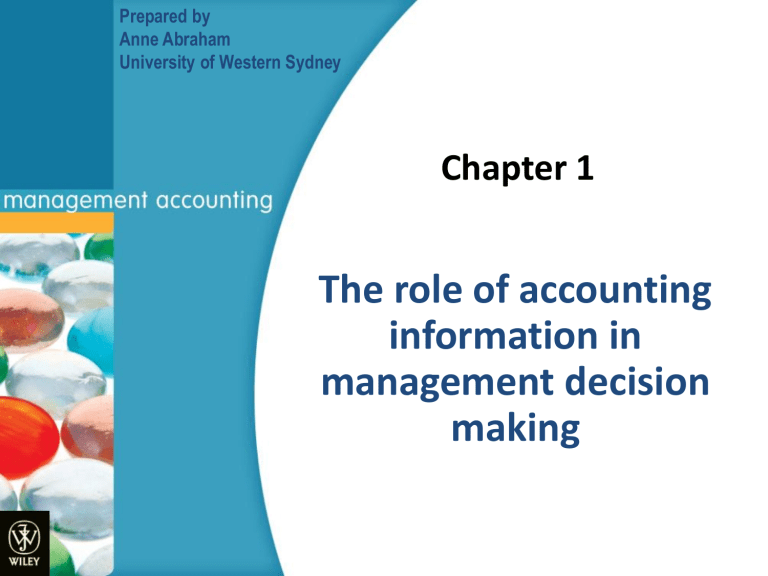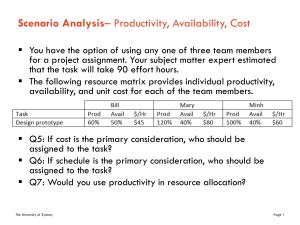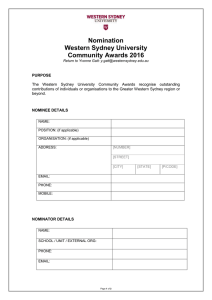
Prepared by Anne Abraham University of Western Sydney Chapter 1 The role of accounting information in management decision making Management decision making Organisational vision Organisational strategies Operating plans Actual operations Core competencies Overview of management decision making Prepared by Anne Abraham, University of Western Sydney 2 MANAGEMENT DECISION MAKING continued • Organisational vision is the core purpose and ideology which guides an entity’s – overall direction – approach to its stakeholders • Organisation core competencies are the entity’s strengths relative to competitors Organisational vision Vision helps locates strengths Strengths help shape vision Prepared by Anne Abraham, University of Western Sydney Core competencies 3 MANAGEMENT DECISION MAKING continued • Organisational strategies – Tactics that managers use to work toward the organisational vision while taking advantage of the core competencies – Long term in nature – Include organisation structure, financial structure, and long-term resource allocation strategies Prepared by Anne Abraham, University of Western Sydney 4 MANAGEMENT DECISION MAKING continued • Operating plans – Involvement short-term implementation of organisational strategies – Include specific performance objectives such as budgeted revenues and costs • Actual operations – Actions taken and the results achieved over a period of time – Data is collected and measured by the organisation’s information system Prepared by Anne Abraham, University of Western Sydney 5 MANAGEMENT DECISION MAKING continued • Measuring, monitoring and motivating performance – Managers use results of operations to monitor performance and ensure it is in line with organisational vision – Results of operations make managers re-think organisational vision or their view of the organisation’s core competencies Prepared by Anne Abraham, University of Western Sydney 6 COST AND MANAGEMENT ACCOUNTING FOR DECISION MAKING Financial accounting prepares reports most frequently used by decision makers external to the organisation Management accounting prepares reports most frequently used by decision makers internal to the organisation Cost accounting is a “method for measuring the cost of a project, process, or thing” It includes both financial and nonfinancial information and is used for both financial and management accounting Prepared by Anne Abraham, University of Western Sydney 7 COST AND MANAGEMENT ACCOUNTING FOR DECISION MAKING continued External reporting Shareholder reports • Financial statements • News releases Other stakeholder reports • Credit reports • Inventory reports for suppliers Government reports • Tax returns • Cost reports Internal reporting Support organisational strategies • Capital budgets • Product development • Analysis of potential acquisitions Support operating plans • Operating budgets • Analysis of product mix • Cash flow plan Monitor and motivate • Actual vs planned performance • Bonus computations • Supplier quality Prepared by Anne Abraham, University of Western Sydney 8 Key influences on management accounting system structure • • • • • • Organisational structure Availability of information technology Organisational strategies Organisation view of management accounting Types of decisions confronting managers External influences Prepared by Anne Abraham, University of Western Sydney 9 Cost and management accounting, yesterday and tomorrow • Early 1900s to mid 1970s: Cost accounting practices changed little • More global environment: Term ‘management accounting’ used for range of activities undertaken • Today: Cost and accounting information used for – decision making – measuring and monitoring performance – goal alignment Prepared by Anne Abraham, University of Western Sydney 10 Relevant information for decision making • Relevant information – Helps decision maker to evaluate and choose among alternative courses of action – Concerns the future – Varies with the action taken • Relevance of information depends on type of decision and other factors • Irrelevant information does not vary with the action taken and therefore is not useful for decision making Prepared by Anne Abraham, University of Western Sydney 11 MANAGEMENT ACCOUNTING INFORMATION AND THE QUALITY OF DECISION MAKING • 2 issues: – Quality and relevance of management accounting information – Quality of decision-making processes in use within organisation • Higher quality information will generally have fewer uncertainties if it is based on viable assumptions Prepared by Anne Abraham, University of Western Sydney 12 MANAGEMENT ACCOUNTING INFORMATION AND THE QUALITY OF DECISION MAKING continued Higher quality information is more - certain - comparable - complete - relevant - timely - valuable Higher quality reports are more - relevant - understandable - available Higher quality decision-making process is more - thorough - unbiased - focussed - strategic, creative and visionary Higher quality decisions Path to higher quality management decisions Prepared by Anne Abraham, University of Western Sydney 13 MANAGEMENT ACCOUNTING INFORMATION AND THE QUALITY OF DECISION MAKING continued • Decision-useful information needs to be considered in light of – Opportunity costs – Cost-benefit analysis • Opportunity costs are the benefits foregone when we choose one alternative over the next best alternative • Cost-benefit analysis is an evaluation of the benefits derived from the information and the costs of collecting it Prepared by Anne Abraham, University of Western Sydney 14 VALUE CHAIN ANALYSIS: A FRAMEWORK FOR MANAGEMENT ACCOUNTING • A value chain consists of the key activities engaged in by an organisation or industry • At the organisational level, the value chain is usually viewed as a combination of key activities and support activities • The value chain provides a suitable framework for considering a range of management accounting issues Prepared by Anne Abraham, University of Western Sydney 15 VALUE CHAIN ANALYSIS continued • Focuses on activities • Encourages a broader organisational view • Breaks down more traditional representations of organisational activity • Externalises thinking by incorporating suppliers and customers • Reinforces initiatives such as ABC • Provides foundation for outsourcing and strategic alliance decisions • Supports initiatives like supply chain analysis • Categorises activities as value-added and nonvalue-added Prepared by Anne Abraham, University of Western Sydney 16 VALUE CHAIN ANALYSIS continued • The supply chain is the flow of resources from the initial suppliers through the delivery of goods and services to customers and clients • A value-added activity is one that is necessary and that the customer would normally be prepared to pay for • A non-value-added activity is one that is wasteful (unnecessary) and that the customer would not normally be prepared to pay for Prepared by Anne Abraham, University of Western Sydney 17 Cost objects and cost drivers • A cost object is a something for which we measure costs (e.g. product, service, production activity, customer, product) • A cost driver is the input or activity that causes changes in the total cost for a cost object – Structured: relate to underlying economic structure of organisation – Executional: relate to ability of organisation to do what is does successfully Prepared by Anne Abraham, University of Western Sydney 18 Cost objects and cost drivers continued • • • • • Structural cost drivers Scale Scope Experience Technology Complexity • • • • • • Executional cost drivers Workforce involvement Total quality management Capacity utilisation Plant/process layout efficiency Product configuration Linkages with suppliers and customers Prepared by Anne Abraham, University of Western Sydney 19





